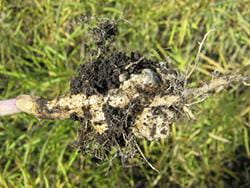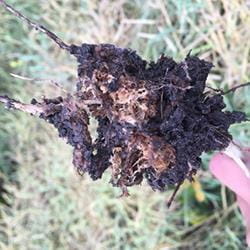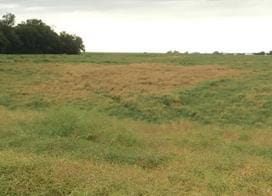What is clubroot?
Clubroot is a soil-borne disease caused by the pathogen Plasmodiophora brassicae. Clubroot affects the roots of cruciferous field crops such as canola, mustard, camelina, oilseed radish and taramira, and cruciferous vegetables such as arugula, broccoli, Brussels sprouts, cabbage, cauliflower, Chinese cabbage, kale, kohlrabi, radish, rutabaga and turnip. Cruciferous weeds (such as stinkweed, shepherd's purse and wild mustard) can also serve as hosts.
Root infection of host plants by the clubroot pathogen results in swelling of the root tissue (galls), which reduces the plant’s ability to obtain water and nutrients from the soil, resulting in yield loss. The level of yield loss will be related to the amount of pathogen in the soil, the susceptibility of the host crop and environmental conditions.
Symptoms
- Clubroot-infected roots will have swollen root tissues (galls).
- Clubroot galls will initially appear white and fleshy. Later in the season they will start to decompose and appear rotten.
- Above-ground symptoms of stunting, yellowing and premature ripening may occur. These symptoms may indicate the presence of a clubroot patch, but could also be associated with other diseases or adverse environmental conditions. As a result, it is important to examine plant roots for the presence of clubroot galls.
 |
 |
 |
Clubroot disease development
The clubroot pathogen overwinters in the soil as long-lived, hardy resting spores. The resting spores may survive in the soil for up to 20 years and have been documented to have a half-life of two to four years. In the spring the resting spores germinate to produce zoospores. Zoospores have two flagella (tails) that enable them to swim very short distances in water or water film in the soil to come in contact with and infect root hairs.
During this initial stage of infection, no symptoms are visible with the naked eye. Within the infected root hairs, the pathogen multiplies and forms a plasmodium (a naked mass of protoplasm with numerous nuclei), which will divide to form secondary zoospores. The secondary zoospores are released back into the soil as the root hairs begin to decompose.
These secondary zoospores then re-infect the plant roots and are able to cause infection in the interior of the root (root cortex). At this stage, the pathogen will form secondary plasmodia in the infected cells and cause hormonal changes that result in an increase in cell size and cell number. This leads to swelling of the infected tissue, producing clubroot galls. The size of the gall is related to the amount of pathogen in the soil present to cause infection. At low pathogen levels, galls are small and have a minimal impact on yield compared to large galls, which occur when pathogen levels are high.
As the plasmodia mature they divide into many resting spores, which fill the cells of the infected root tissue. At the end of the growing season, the galls start to decay and release the resting spores back into the soil to cause infection the next time a susceptible crop is grown. Every time a susceptible crop is grown, more resting spores are returned to the soil, increasing the pathogen populations and potential yield loss the next time a susceptible crop is grown.
Clubroot prevention
Clubroot resting spores survive in the soil and can be moved any way that soil can be moved. This includes soil movement on agriculture or industrial equipment, vehicles, tires, shoes, animals, wind or water erosion, or contaminated inputs such as manures. Activities that move large volumes of soil are considered to have a higher risk, as do activities that move soil over large geographic regions and from regions where clubroot is known to be present.

The focus of clubroot prevention is preventing the introduction of clubroot-infected soil. The following practices can be used to prevent clubroot introduction and minimize the spread of clubroot once it has been confirmed in a field and/or region:
- Practise good sanitation to restrict soil movement;
- Knock soil off equipment between fields;
- Minimize traffic to and from fields;
- Practise zero or minimum tillage, which will reduce the movement of clubroot-infected soil through water and wind erosion;
- Create a separate exit as far as possible from the field entrance. Clubroot is often first found at the field entrance, and this area of the field will often have the highest concentration of the pathogen. Exiting the field as far as possible from the field entrance will reduce the amount of pathogen in the soil on equipment leaving the field;
- Notify occupants and landowners who have access to the land if clubroot has been confirmed; and
- Talk openly about biosecurity with all groups working on your land.
Clubroot management
- Restrict movement of potentially contaminated soil on vehicles and equipment;
- Extend your crop rotation; include a break of at least two years, preferably three, between susceptible crops even when clubroot-resistant varieties are used;
- Grow clubroot-resistant varieties;
- Scout canola crops by examining roots for the presence of clubroot galls; focus scouting on field entrances, low areas, and suspicious patches;
- Collect soil and submit it to a laboratory for a DNA-based clubroot test; the test results will provide early detection of the clubroot pathogen and enable early management when pathogen levels are low; and
- See the Clubroot Management and Scouting Tips document for more information.
The key to clubroot management is to keep pathogen levels low to allow continued canola production in the infested fields with minimum impact on yield.
Clubroot in Saskatchewan
All findings of visible clubroot symptoms and the detection of the pathogen using DNA-based testing since 2008 have been used to produce a cumulative Saskatchewan Clubroot Distribution Map. This map illustrates the location, to a rural municipality (RM) level, of all findings of clubroot and the clubroot pathogen from 2008 to 2023 and provides an estimate of regional risk. This is a useful tool that can be used to identify areas in the province that have the highest clubroot risk. However, it is important to remember that no detection of clubroot in an RM does not mean it is not there. The distribution of clubroot and the clubroot pathogen across the northern agricultural region indicates that the risk is not isolated to a small area. All producers in Saskatchewan are encouraged to monitor their fields and think proactively about clubroot management.
